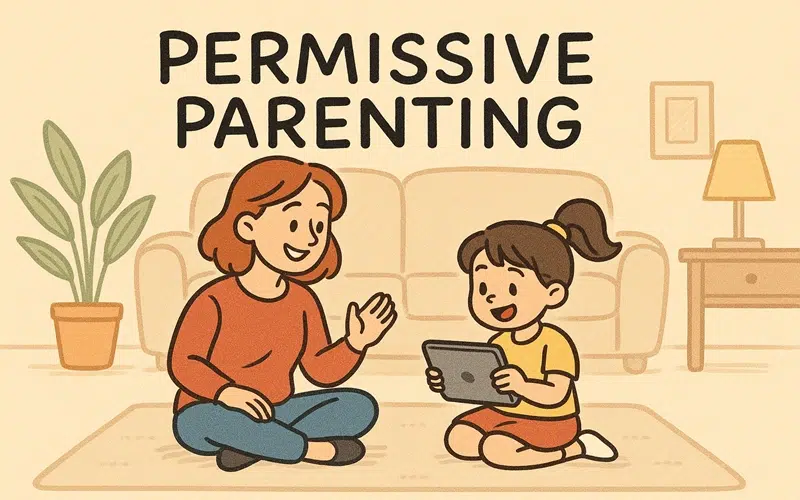When we talk about how parents raise their children, there are different styles. One of them is called permissive parenting. This style is all about being loving and kind but not setting many rules or boundaries. Some parents think this is the best way to make their children happy and feel free. But is it always a good thing? In this article, we’ll explore what permissive parenting is, what it looks like, its effects, and how it compares to other parenting styles.
What is Permissive Parenting?
Permissive parenting is a style where parents are very warm and caring but don’t like to say “no” to their children. They often avoid setting strict rules and may allow their kids to make many decisions on their own—even at a young age.
These parents often want to be their child’s friend more than their boss. They might give their child candy for breakfast, let them stay up late, or skip homework without much worry. While their hearts are in the right place, this way of parenting may lead to problems later on.
Read More: chelsea acton famousparenting
Key Features of Permissive Parenting
Here are some common traits that show someone is using permissive parenting:
-
Few Rules or Limits: The child can often do what they want, even when it’s not the best choice.
-
Avoiding Discipline: When a child breaks a rule, the parent may not give a consequence or may give in easily.
-
High Love, Low Control: These parents give a lot of affection but don’t guide their child’s behavior much.
-
Kids Make the Decisions: Children often decide what they eat, when they sleep, or how much screen time they get.
-
Fear of Saying “No”: Parents don’t want their child to be upset, so they often say “yes” even when they don’t agree.
Why Do Parents Choose Permissive Parenting?
There are many reasons why a parent may use this style. Sometimes, they grew up with very strict parents and want to be more gentle. Others may feel guilty because they work a lot or are separated from their child due to divorce or other reasons.
Some parents think children will grow better if they have full freedom. Others are simply tired and find it easier to say “yes” than argue.
Effects of Permissive Parenting on Children
Letting children do whatever they want may sound nice, but it can bring some challenges. Research shows that permissive parenting can lead to:
1. Lack of Self-Control
Kids raised this way may not learn how to control their feelings or actions. Since no one tells them “stop” or “wait,” they may act out in school or with friends.
2. Low Responsibility
When there are no rules, children may not feel they need to follow through on tasks like chores, homework, or helping others.
3. Poor Social Skills
If a child always gets what they want at home, they might struggle to share or take turns with others.
4. More Risky Behavior
Teenagers from permissive homes may try dangerous things like smoking, drinking, or skipping school, since they were not taught boundaries.
5. Lower School Performance
Without discipline and support, some children may struggle with their studies and get poor grades.
How Does Permissive Parenting Compare to Other Styles?
Experts often talk about four main parenting styles:
| Parenting Style | Control | Warmth | Rules | Discipline |
|---|---|---|---|---|
| Authoritative | High | High | Clear | Fair |
| Authoritarian | High | Low | Strict | Harsh |
| Permissive | Low | High | Few | Rare |
| Neglectful | Low | Low | None | None |
As you can see, permissive parenting offers lots of love but not much structure. The authoritative style is often seen as the best—it mixes love and firm rules to help kids grow strong and responsible.
Real-Life Examples of Permissive Parenting
To understand it better, here are a few examples:
-
A child doesn’t want to eat vegetables. The parent says, “Okay, just eat cookies instead.”
-
It’s bedtime, but the child wants to watch TV. The parent agrees because they don’t want to argue.
-
The child hits their sibling. The parent says, “That’s not nice,” but doesn’t do anything else.
These might seem like small things, but over time, they shape how a child learns right from wrong.
Can Permissive Parenting Be Balanced?
Yes! If you are a permissive parent, it’s not too late to find balance. You can still be loving and caring while also setting rules and teaching discipline. Here’s how:
1. Start Small with Rules
Pick a few important rules like bedtime or homework time. Stick to them and explain why they matter.
2. Be Consistent
Don’t give in every time your child whines or cries. Stay calm and repeat the rule.
3. Offer Choices Within Limits
Let your child pick between two healthy snacks, or choose between reading or puzzles at night. This gives freedom but also teaches decision-making.
4. Use Gentle Discipline
Discipline doesn’t have to be harsh. Time-outs, loss of privileges, or calm talks can help your child understand consequences.
5. Praise Good Behavior
Notice when your child follows rules or shows kindness. A simple “Great job!” goes a long way.
Can Permissive Parenting Ever Be Good?
There are a few good things about permissive parenting:
-
Kids feel loved and accepted.
-
Children may be creative and confident.
-
They are often less fearful of making mistakes.
But for these benefits to shine, parents need to add some structure and guidance. Love alone isn’t enough to prepare a child for real life.
Tips for Parents Who Use the Permissive Style
If you think you’re a permissive parent and want to improve, here are some simple tips:
-
Make a schedule: Set times for meals, sleep, and homework.
-
Talk about rules: Explain why rules help keep kids safe and strong.
-
Practice saying “no”: It’s okay to say no if something isn’t right.
-
Use positive words: Instead of yelling, speak in a calm and firm voice.
-
Learn from mistakes: Parenting is hard. Every day is a chance to do better.
Conclusion
Permissive parenting comes from a place of love, but without enough rules and guidance, it can lead to problems for children. While it’s good to show kindness and let your child feel heard, kids also need clear limits to grow up happy, healthy, and responsible.
By making small changes—like setting rules, using calm discipline, and being consistent—parents can create a better balance between love and leadership. In the end, children benefit the most when parents are both warm and firm.
FAQs
Q1: Is permissive parenting always bad?
No, it’s not always bad. Showing love and support is great, but it works best when mixed with rules and guidance.
Q2: How can I tell if I’m a permissive parent?
If you often say “yes” to avoid arguments, don’t set many rules, and let your child make big choices, you might be using permissive parenting.
Q3: Can permissive parenting be changed?
Yes! Parents can learn to add more structure and discipline while still being loving and kind.
Read More: cashstark com



